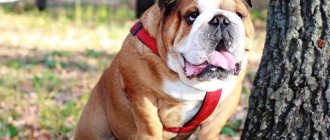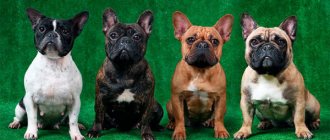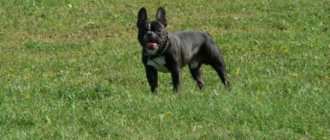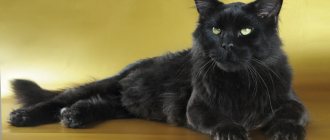Image by 1tamara2 from Pixabay
The secret of the black color of the fighting breed lies in its origin. When crossing dogs with brindle fur, gene mutations accumulate, leading to a rich dark color in the offspring. The solid black French Bulldog is not included in the standard. Common colors of French dogs are brindle, red, fawn, less common are blue, white, chocolate, black and white representatives of the elite breed.
French bulldog colors
The following colors are allowed according to the breed standard:
- brindle;
- black and brindle;
- pale yellow;
- fawn-variegated;
- fawn brindle.
French dogs are spotted (bicolor), with white spots covering either only the neck, chest, limbs, or half of the body, or predominate. Solid snow-white coat color is rare because it is genetically recessive, but is acceptable by the standard.
Unauthorized suits:
- black;
- blue;
- chocolate;
- beige;
- tortoiseshell (tricolor);
- tan (brown-red and black-red);
- bicolor black and white.
Irregularly colored French Bulldogs do not compete in shows, but that doesn't stop them from being wonderful companions.
Regardless of color, a purebred puppy should have black eyelids and a nose. The iris is rich brown. Other earlobe and eye colors occur, but are not included in the standard.
Tricolor French Bulldog, photo by Collins Lesuli on Unsplash
Kinds
Dog handlers distinguish classic colors and mixed, non-standard ones. The first include:
- Pale yellow.
- Brindle.
- Ginger.
- Bicolor (black and white with exactly the acceptable size of spots and tans).
- Cream.
Types of rare colors unacceptable by standards:
- White with black spots.
- Mousey.
- Smoky.
- Liver.
- Blue.
- Tan.
- Pure black.
Below, you will learn more about the colors and look at photos of all types.
“Defective” colors do not affect the popularity of the breed; on the contrary, bulldogs of rare colors are highly valued among buyers, despite the fact that such animals will not be able to take part in exhibitions.
Black
Black dogs are outside the breed standard. They can have different degrees of color intensity (variations of dark brown, brown and tan, black and tan), depending on the genes. A black French bulldog may have a white shirt front and a white collar. Owners of dogs of this color are advised to closely monitor their pet in the heat - black bulldogs can overheat in the sun. It is also necessary to carefully examine the dog after a walk - ticks, wounds or other damage may not be noticeable on dark fur.
Gray
Gray and gray-blue (mouse) colors are also not accepted by the breed standard. However, dogs of these colors are quite common and are popular. The gray color of the coat varies, from light to metallic, it can be plain and “highlighted”, with tan marks. The coat of dogs of this color is short, shiny, there may be some white spots on the chest, but most often the color is uniform throughout the body.
Redheads
The red color is a variety of fawn. A bulldog of this color will be welcome to be seen at exhibitions, but with reservations: the presence of white spots on the animal’s body is allowed, except for the belly, neck and chest. Red dogs may have a black mask on their face or brindle markings all over their body. Red is the main color on which fawn marks, spots, masks, and so on are located. Red is considered a variety of red; it is considered one of the elite colors of French bulldogs.
Breed standards are guided by a fairly simple rule: everything that exists in nature is accepted for breeding, for example, red - a natural color obtained without the participation of breeders.
Blue
Blue color is a type of gray, but you can distinguish it, as they say, by eye. The blue puppy has a clay blue coat that is shiny and silver with a visible hint of blue. Such dogs look elegant, but are not approved by the standard. These bulldogs often have blue eyes, which makes the puppies even more popular among buyers. Blue Bulldogs may have white patches on the chest, but most often it is a solid color throughout the body, with no blotches or spots. Official breeders do not accept such bulldogs for breeding, since the blue gene can produce blue and lilac puppies, which is unacceptable for show animals.
Merle
Merle or merle is a marbled coat color. The breed standard does not recognize him. Bulldogs are unevenly colored, there are three colors, on the body there are fuzzy spots of different sizes and shades, most often coffee, brown and white alternate. With the merle color, as a rule, there is no usual mask on the face; dogs often have eyes of different colors. If bulldog owners can only be pleased with such features, dog experts consider merle to be a genetic deviation.
Chocolate
Chocolate color is a uniform, rich brown or brownish brown with a slight sheen. There may be different shades, but in general the color will always be monochromatic. Such bulldogs may have longitudinal white spots on the neck and belly; there is no mask on the face. The chocolate color is artificially bred by breeders; the bright brown coat is considered a defect. However, if it is a variation of brindle or fawn, then it will be accepted as the standard.
Brindle
Brindle color is considered the most common color among French bulldogs. It can be recognized by the characteristic alternation of red and black stripes on its fur. There may be milky markings on the chest and neck, and a mask on the muzzle. Color is transmitted genetically, brindle is a dominant trait, puppies of such colors are distinguished by good health, they are mobile and active. The breed standard accepts the presence of patches of black or red hair on the coat, which give this color its name.
Fawn
Fawn color includes various shades - from red, brown (cappuccino) to wheat, light. The standard allows for this color to have various spots on the forehead, chest, neck and belly.
If the spots are located in other places, the puppy is rejected.
The most common colors of dogs are:
- Fawn with black hairs (speckles).
- Fawn - brindle (there are black transverse stripes).
- Fawn with spots and white-fawn. According to the standard, spots should not occupy an area of more than 20% of the total background.
White
Because the white gene is recessive, bulldogs carrying it are rare. The wool is snow-white or milky. Markings of any color except black are acceptable. The muzzle is often decorated with a dark “mask”.
View this post on Instagram
Posted by Zevs (@zevs_frenchbull)
White-haired French bulldogs have a strong immune system. But there is a high probability that newborn white puppies will be hard of hearing or deaf.
How do puppies change as they age?
When choosing a puppy, it is important to remember that newborn bulldogs have colors that will change with age. The main color is visible immediately, but it is possible to understand whether the dog will meet all breed standards only after some time. By two months, spots and other marks will already be clearly visible on the body. By six months, the puppy will have developed body contour and muscle mass. By 7 months, a mask on the face will appear (if present). And only by 11 months the color will be clearly expressed and will become close to the color with which the bulldog will live its entire life.
If a puppy is acquired from purebred parents, then you can understand its color based on its pedigree. The breeder will show all relevant documents guaranteeing that the puppy was born from parents without dominant blue, lilac genes.
Black
View this post on Instagram
Posted by Barney French bulldog to Moscow (@puppies_from_barney)
The black bulldog is the rarest variety. A continuous color is obtained by crossing brindle dogs for a long time.
The black-haired French pet is excluded from participation in competitions and breeding. Therefore, the black cubs born are castrated. The bulldog is bought exclusively as a companion; in terms of character traits, it is in no way inferior to the varieties recognized by the standard.
It is necessary to distinguish between solid and black-and-white bulldogs. The intensity of the color is influenced by the genetic characteristics of the individual. Since the variety was obtained by crossing brindle dogs, in the vast majority of cases the body is not black, but motley. It’s just that the specks and stripes are small, almost merge with the black background, and are difficult for human eyes to notice. The chest and limbs are decorated with white and beige spots; less often, markings cover the back.
Provisions of the standard
The breed standard states that all French Bulldog colors can be divided into two groups:
- With uniform color.
- With a spotted color.
The first group is also divided into brindle and fawn, while the second group is distinguished by the presence of brindle and fawn markings on the main white color of the coat.
Allowed
The following characteristics apply to the brindle color: the main color is bronze or fawn, red or black, with areas of black and red hairs, with marks of white on the chest, neck and muzzle. A mask is allowed, but it is most often barely visible. The fawn color can change in saturation - from red to wheaten, light. The color “coffee with milk”, rusty, red tint is allowed.
Dogs of this color must have a white belly, white markings are allowed on the neck and chest, and there should be no such markings on the head, except for a small stripe from the nose to the forehead. Masks are acceptable, claws are black. Spotted color with a base white may contain: brindle or fawn markings on the head, ears, sides, back. Spots no more than 20% of the total area. In addition to the main colors, cream, black with white spots (bicolor) are allowed.
Prohibited
Colors that will disqualify a dog include:
- Brindle color, if the main color is bright bronze.
- Spotted, if the markings merge, there is subtle pigmentation on the eyelids, lips, and nose.
- Gray (blue).
- Mousey.
- Chocolate.
- Tricolor.
- Black.
- Tiger blue and tiger chocolate.
- Fawn with blue markings.
- Lilac.
- Merle.
Puppies of this color have a note in their documents indicating the impossibility of breeding, in fact, a marriage. Such bulldogs cannot take part in exhibitions, but their external attractiveness most often does not leave such dogs without owners - non-standard colors are valued among buyers.
Merle color
It's marble. Not included in the breed standard, although the genes that form it are dominant. Three shades (in most individuals white, reddish brown and dark brown) form vague patterns of different shapes and sizes. There is usually no “mask”.
View this post on Instagram
Posted by @frenchbulldog.puppies.ua
Marbled bulldogs often have heterochromia (unequal coloration of the iris). There is a high probability of having a litter with genetic abnormalities.
Fawn
Solid coat color, formed by both recessive genes and dominants. Differs in shade variability: from light brown to rich red. Tonal variations of each shade in the direction of paling and darkening are possible. The muzzle is decorated with a “mask”; there are small white spots on the chest and belly.
View this post on Instagram
Posted by Aleksandra_ailan'zon (@aleksandra_ailan_zon)
Fawn hairs can vary in tone depending on the length: short ones are lighter, long ones are darker. Dogs whose red hairs have silver tips are called fawn-blue. There are also fawn-tiger individuals (with a predominance of fawn) and fawn-variegated (with a predominance of black areas).
Rare
Breeders are working on developing new shades, often producing exotic colors for dogs. Among bulldog owners, white, lilac and blue ones are especially valued. All these shades are extremely rare. Not all exotic colors are allowed by the standard and can be used for further breeding. For example, purple and black are outside the standard, but cream and bicolor are acceptable.
Bicolor
Bicolors include two-color dogs, among which the most common type is black-white or white-black (depending on which color is the main one). In this case, the standard allows color if the spots are located on the back, sides, head (ears, forehead, cheeks) and occupy no more than 20% of the total body area. Limited spotting is allowed - the spots occupy a minimum area of the main color, located on the chest, paws, and on the neck in the form of a tie.
Cream
Cream-colored dogs (also a type of brindle) have light noses, lips and eyelids; this is the main difference between the color and all others. This color is accepted by the American breed standard, but it is extremely rare and therefore highly valued among breeders.
Blue
If there is a mention of blue French bulldogs, then most likely we are talking about a blue dog. They just call it differently to more specifically describe the color, saying that the shade is rich and rare. The blue coloring of bulldogs is gray and silver. This color is very beautiful, but a pet of this color will not be allowed to the exhibition, this is a defect.
Red
Red bulldogs belong to the elite group of colors. Such dogs are valued among dog handlers, they are bred, and they conquer experts at various exhibitions. Red is a rich shade of red or fawn. The cost of such dogs is quite high precisely because of their high breeding.
White
Snow-white bulldogs are an incredible rarity, most often they are congenital albinos. This is a easily soiled color that requires special care. Many puppies that appear white at first glance turn out to be brindle or cream. White color is not allowed by the standard.
Which color to choose
There is no difficulty in choosing a color if you understand the purpose of the acquired French bulldog. A show dog must have exclusively a color confirmed by the standard. A puppy who will become just a companion can have any coat color, but you need to take into account that some varieties (blue, white, marbled) are susceptible to genetic pathologies.
Many people buy black bulldogs because they have advantages:
- Their fur is non-staining and dirt is not visible on it. Consequently, caring for dogs is easier, bathing has to be done less often.
- Black French bulldogs are less susceptible to allergic reactions than their light counterparts.
- Black-haired pets have stronger immunity and stronger bodies. This is due to the genetic characteristics of the breed: the paler the coat, the weaker the dog’s body. And the stronger the health, the longer the pet lives. A black bulldog can live up to 13-15 years.
Animal character
The character of the black “Frenchman” is absolutely the same as that of his brothers of other colors.
This breed is quite controversial.
On the one hand, the French are quite lazy and imposing and will gladly keep their owner company on the sofa. On the other hand, puppies are distinguished by their activity and playfulness, which in most cases continues into adulthood.
French bulldogs are distinguished by their excellent intelligence . The dog understands its owner well and is prone to empathy. However, they are not always obedient.
Sometimes you have to repeat a command more than a dozen times for your pet to deign to carry it out. This is due to willfulness and unwillingness to obey.
Although, as dog handlers note, Frenchies are quite amenable to training , but mastering commands will require a lot of effort and patience .
Also, do not forget that dogs of this breed can have different temperaments. For example, choleric people quickly get tired of the training process and begin to shirk.
Phlegmatic people need to be worked at a calm pace. But for sanguine and melancholic people, it is recommended to turn the training process into a fun game.
French Bulldogs are extremely friendly.
They are not at all averse to interacting with small children, and their easygoing nature makes them an excellent friend for your son or daughter, because you can be sure that the dog will not attack them or decide to go AWOL during a walk.











